"Warnings about climate change usually carry the implied message that any change is going to be disastrous. Only seventeen thousand years ago, New York City, Toronto, and Stockholm were buried under a mile of ice. (In a 4-billion-year history, 17,000 years is the day before yesterday.)"
Kenneth Deffeyes is Professor Emeritus in Geology, Princeton University, and author of Hubbert's Peak, Beyond Oil and When Oil Peaked.
Those of us in the “Peak Oil Community” - as it is called - believe that Peak Oil will lead to a paradigm shift on the order of the Industrial Revolution. And we generally believe that Peak Oil is “upon us”. But with substantial challenges, come substantial opportunities …
Tuesday, December 14, 2010
Sunday, November 21, 2010
Wayne Keith unofficially breaks woodgas world speed record ...
Wayne Keith is a modern-day woodgas pioneer, a "deacon" of the woodgas community, if you will. Back in 2008, Wayne and crew won second place in the Escape from Berkeley alternate fuel race.
I had the pleasure of spending Friday, November 19, 2010 with Wayne Keith and family. Wayne first demonstrated his woodgas F150 experimental platform, as well as his woodgas Dakota "daily driver". Later we took the Dakota out for a spin around the backroads of St. Clair County, Alabama. Then, Wayne decided we should "stretch its legs" a little, so onto the Interstate we went. With a good head of woodgas and about 640 F coming into the headache rack heat exchanger, we topped out at about 85 MPH - but only because of traffic! We just couldn't get the cars out of the way on the stretch we were running. But since that is almost twice the current official record of 47 MPH, so we decided to call it a day. If it looks like we were going fast in the video, it's because we were! As you will see, Wayne startled me a little when he took the exit ramp like he had a little Earnhardt in him. No, we didn't roll the Dakota - I just quit videoing. What a fun and instructive day! Many thanks to Mr. Wayne and his family!
Wayne Keith's unofficial woodgas world speed record video:
More on Woodgas
Woodgas is quite simply a combination of H2 & CO, with a little CH4 or other heavies, plus the N2 that comes along for the ride from the air. Woodgas is produced when wood is pyrolyzed and the products are partially combusted and then reduced, forming the CO and H2.
The "technique" of producing woodgas has its roots dating to the early 1700's. Those early 1800's gas lights in Paris and the US were not from gas wells, but rather from producer gas - aka town gas or hydro gas - which is a cousin to woodgas, and is usually produced from coal.
Woodgas burns with a beautiful pink/purple flare, and is conducive to higher compression and advanced timing setups when used in existing internal combustion engines.
Video of the pre-startup flare from a Power Pallet, at the October 2010 All Power Labs workshop:
Woodgas falls into the partial solution category, with respect to our coming liquid fuels crisis. Woodgas burns cleaner than gasoline or diesel, but it is problematic in terms of operation, at least in terms of the expectations of today's drivers, who expect to be able to turn the key and drive without another thought as to what is going on in the engine. Operating a gasifier and the related systems currently requires mechanical experience and attention to detail. However, it may be possible to work out some of these issues. Also, the difficulties of dealing with a gasifier might be more palatable when it is your only choice for getting from point A to point B in your vehicle.
As an example of this line of reasoning, the Department of Energy thought enough of woodgas as an emergency fuel that in 1989 their FEMA arm sponsored the Oak Ridge National Laboratory to design a makeshift woodgas generator which could be constructed out of commonly available materials - in this case metal trash cans and a stainless salad collander, and a few other parts! The resulting design was problematic in terms of tar production (not desirable for engines) so it is shunned in woodgas circles. However, the fact that the DOE was interested in the technique as a potential, partial solution to a severe petroleum shortage - should be instructive. Gasifiers were used to power approximately one million cars, buses, trucks, trains, boats and generators during WWII, in Europe (Egloff 1943).
We have referred to woodgas in a few prior posts:
The coming liquid fuels crisis: the natural gas partial solution.
Oilpatch engineer replies to peak oil activist.
Last month I attended a wonderfully interesting three day workshop on gasification at Jim Mason's All Power Labs in Berkeley, California. Jim has unselfishly created an open source project to further the development of woodgas, and All Power Labs now has several products available for developers. The Gasifier Experimenters Kit, or GEK, is available for purchase, as is the Power Pallet - a pallet-sized package consisting of a GEK supplying a 10 KW Kubota genset with woodgas. During the workshop, with the assistance of Jim's friendly and motivated young staff, I was able to help construct a GEK and a Power Pallet. We also witnessed an extended run of the Power Pallet - it is amazing to watch ordinary woodchips be converted into electricity on a small scale! I intend to "write up" the workshop - the people, the experience and the education - but have not yet had a chance to put the notes in final form. In the meantime, details of the workshop and some pictures and videos can be found on All Power's website:
http://www.gekgasifier.com/
I had the pleasure of spending Friday, November 19, 2010 with Wayne Keith and family. Wayne first demonstrated his woodgas F150 experimental platform, as well as his woodgas Dakota "daily driver". Later we took the Dakota out for a spin around the backroads of St. Clair County, Alabama. Then, Wayne decided we should "stretch its legs" a little, so onto the Interstate we went. With a good head of woodgas and about 640 F coming into the headache rack heat exchanger, we topped out at about 85 MPH - but only because of traffic! We just couldn't get the cars out of the way on the stretch we were running. But since that is almost twice the current official record of 47 MPH, so we decided to call it a day. If it looks like we were going fast in the video, it's because we were! As you will see, Wayne startled me a little when he took the exit ramp like he had a little Earnhardt in him. No, we didn't roll the Dakota - I just quit videoing. What a fun and instructive day! Many thanks to Mr. Wayne and his family!
Wayne Keith's unofficial woodgas world speed record video:
More on Woodgas
Woodgas is quite simply a combination of H2 & CO, with a little CH4 or other heavies, plus the N2 that comes along for the ride from the air. Woodgas is produced when wood is pyrolyzed and the products are partially combusted and then reduced, forming the CO and H2.
The "technique" of producing woodgas has its roots dating to the early 1700's. Those early 1800's gas lights in Paris and the US were not from gas wells, but rather from producer gas - aka town gas or hydro gas - which is a cousin to woodgas, and is usually produced from coal.
Woodgas burns with a beautiful pink/purple flare, and is conducive to higher compression and advanced timing setups when used in existing internal combustion engines.
Video of the pre-startup flare from a Power Pallet, at the October 2010 All Power Labs workshop:
Woodgas falls into the partial solution category, with respect to our coming liquid fuels crisis. Woodgas burns cleaner than gasoline or diesel, but it is problematic in terms of operation, at least in terms of the expectations of today's drivers, who expect to be able to turn the key and drive without another thought as to what is going on in the engine. Operating a gasifier and the related systems currently requires mechanical experience and attention to detail. However, it may be possible to work out some of these issues. Also, the difficulties of dealing with a gasifier might be more palatable when it is your only choice for getting from point A to point B in your vehicle.
As an example of this line of reasoning, the Department of Energy thought enough of woodgas as an emergency fuel that in 1989 their FEMA arm sponsored the Oak Ridge National Laboratory to design a makeshift woodgas generator which could be constructed out of commonly available materials - in this case metal trash cans and a stainless salad collander, and a few other parts! The resulting design was problematic in terms of tar production (not desirable for engines) so it is shunned in woodgas circles. However, the fact that the DOE was interested in the technique as a potential, partial solution to a severe petroleum shortage - should be instructive. Gasifiers were used to power approximately one million cars, buses, trucks, trains, boats and generators during WWII, in Europe (Egloff 1943).
We have referred to woodgas in a few prior posts:
The coming liquid fuels crisis: the natural gas partial solution.
Oilpatch engineer replies to peak oil activist.
Last month I attended a wonderfully interesting three day workshop on gasification at Jim Mason's All Power Labs in Berkeley, California. Jim has unselfishly created an open source project to further the development of woodgas, and All Power Labs now has several products available for developers. The Gasifier Experimenters Kit, or GEK, is available for purchase, as is the Power Pallet - a pallet-sized package consisting of a GEK supplying a 10 KW Kubota genset with woodgas. During the workshop, with the assistance of Jim's friendly and motivated young staff, I was able to help construct a GEK and a Power Pallet. We also witnessed an extended run of the Power Pallet - it is amazing to watch ordinary woodchips be converted into electricity on a small scale! I intend to "write up" the workshop - the people, the experience and the education - but have not yet had a chance to put the notes in final form. In the meantime, details of the workshop and some pictures and videos can be found on All Power's website:
http://www.gekgasifier.com/
Labels:
GEK,
natural gas vehicles,
Peak Oil,
Wayne Keith,
woodgas
Friday, October 15, 2010
Dr. Hirsch's new book: The Impending World Energy Mess
Several folks have asked, "What's up with Peak Oil?".
Well, largely, the "coming energy mess" is masked by the "current economic mess". Namely, when you reduce growth in oil demand - as the world has done over the last several years - you don't notice the fact that the oil production rate really can't grow too much, anyway. At some point, though, the decline in oil production rate and/or the growth in demand ... meet. Or collide, we should say. When? Maybe 6 months, maybe a couple of years. It really depends on oil consumption, which in turn depends on the poor economic conditions that most of the world continues to experience. However, when demand does meet falling supply - look out. Another price shock will occur, then the economy will retract again, and demand will fall - a little, perhaps. But at some point we are down to bare bones - we've cut all discretionary demand, or at least all semi-comfortable, discretionary demand.
You may recall previous posts discussing Dr. Robert L. Hirsch, or the report which bears his name - the "Hirsch Report" - which was completed in 2005. This carefully written, non-sensational, 92 page pdf was entitled "Peaking of World Oil Production: Impacts, Mitigation, & Risk Managment". The Hirsch Report became semi-famous due to its quality, its content and also due to "who wrote it for whom". Namely, Dr. Hirsch, Dr. Bezdek and Mr. Wendling wrote the report for SAIC, who in turn was fulfilling a contract with the U.S. Department of Energy (DOE). (SAIC is a government contractor who some call "the biggest company you've never heard of". A few years ago SAIC went public; they have around 40,000 employees.) Initially the report was kept a "secret" to some extent. That is to say, initially the Hirsch Report could only be found on the website of a California high school! I would suspect that the DOE, etc. felt like it would send out shockwaves when folks read it. What they didn't understand was that since it wasn't a reality TV show, a lot of folks would never hear of it. Namely, a lot of folks just don't read. Further, there is a substantial amount of "thought inertia" out there - people have a hard time wrapping their minds around something so transformative. The Hirsch Report was ultimately placed on the DOE website, and it is currently linked on this blog (as is an interview with Dr. Hirsch, regarding the report).
Dr. Hirsch has been a speaker at the last several conferences held by the Association for Study of Peak Oil, or ASPO-USA. As an attendee at those conferences in 2007-2009, I listened intently to Dr. Hirsch's talks. I also had a few chances to chat with him. Last year I was able to ask him a question from the floor regarding the potential for natural gas vehicles to serve as a partial solution to the coming liquid fuels crisis (Peak Oil).
In observing his mannerisms over the last 3 years, and from his total focus on Peak Oil, it is my belief that the Hirsch Report had a profound effect on Dr. Hirsch himself. And realize that Dr. Hirsch has "done it all" - almost - in the energy business. He has a doctorate in engineering and physics, and has 40 years of experience, 15 patents and 50 technical publications. Dr. Hirsch was director of fusion research at the Atomic Energy Commission (AEC), Manager of Petroleum Exploratory Research at Exxon's Production Research, Manager of Exxon's synethetic fuels lab, VP and Manager for oil and gas research at ARCO, and then a senior staff member at RAND and SAIC.
The key takeaway from the Hirsch Report was that Peak Oil should be "prepared for", not "reacted to". Namely, the Hirsch Report posited that our nation could effectively deal with Peak Oil, given 20 years of intense transition efforts; that is, if we initiated efforts 20 years in advance of the peak. However, if only ten years of transition time are available, the Report predicted a painful transition process. And finally, according to the Report, if serious transitioning is not begun until after the Peak then "serious consequences" will result.
Dr. Hirsch, Dr. Bezdek and Mr. Wendling have now written The Impending World Energy Mess, which was released around October 1, 2010.
The book includes a forward by Dr. James R. Schlesinger, the first U. S. Secretary of Energy, former Chairman of the Atomic Energy Commission, former Director of the Central Intelligence Agency and former Secretary of Defense.
The book doesn't plow a lot of new ground for those of us that have been familiar with Peak Oil. However, the book is an important "signpost" or "threshold" - the first book regarding Peak Oil from a very sophisticated, highly respected, former government analyst. The book is well-written, side-barred and highlighted. It is easy to read, and easy to refer to. The book also goes into substantial detail on various "partial solutions", as well as those which have been "ruled out". Included are excellent discussions on fusion, biomass, ethanol, and coal and gas-to-liquids.
Some of the most valuable content is that of the discussion of possible rationing plans - for gasoline and diesel. Not voluntary rationing - mandatory rationing. Given the circles in which the authors travel, I would imagine that what they have written is similar to what the government might invoke. Some might wonder why a Prius might be better to have than a Corolla, given that the economics never seem to catch up at say, $3 gasoline. However, in addition to being a means to contribute to conservation, an excellent piece of overall fuel efficiency engineering and a highly drivable vehicle, the Prius will go a lot further on a gallon of gas than will a Corolla. This may equalize the economics, somewhat, when it means another ten trips to the grocery store or school, or perhaps an additional 100 miles per ten gallon tankful, vis-a-vis the Corolla.
The Impending World Energy Mess should create additional awareness of Peak Oil - we will see what the reaction/consequences are.
Shown below are a two interviews with Dr. Hirsch, regarding the book, and a book review:
Steve Andrews of ASPO-USA interviews Dr. Hirsch regarding his book
Matthew Auzanneau interviews Dr. Hirsch regarding his book
Tom Whipple reviews Dr. Hirsch's book
Well, largely, the "coming energy mess" is masked by the "current economic mess". Namely, when you reduce growth in oil demand - as the world has done over the last several years - you don't notice the fact that the oil production rate really can't grow too much, anyway. At some point, though, the decline in oil production rate and/or the growth in demand ... meet. Or collide, we should say. When? Maybe 6 months, maybe a couple of years. It really depends on oil consumption, which in turn depends on the poor economic conditions that most of the world continues to experience. However, when demand does meet falling supply - look out. Another price shock will occur, then the economy will retract again, and demand will fall - a little, perhaps. But at some point we are down to bare bones - we've cut all discretionary demand, or at least all semi-comfortable, discretionary demand.
You may recall previous posts discussing Dr. Robert L. Hirsch, or the report which bears his name - the "Hirsch Report" - which was completed in 2005. This carefully written, non-sensational, 92 page pdf was entitled "Peaking of World Oil Production: Impacts, Mitigation, & Risk Managment". The Hirsch Report became semi-famous due to its quality, its content and also due to "who wrote it for whom". Namely, Dr. Hirsch, Dr. Bezdek and Mr. Wendling wrote the report for SAIC, who in turn was fulfilling a contract with the U.S. Department of Energy (DOE). (SAIC is a government contractor who some call "the biggest company you've never heard of". A few years ago SAIC went public; they have around 40,000 employees.) Initially the report was kept a "secret" to some extent. That is to say, initially the Hirsch Report could only be found on the website of a California high school! I would suspect that the DOE, etc. felt like it would send out shockwaves when folks read it. What they didn't understand was that since it wasn't a reality TV show, a lot of folks would never hear of it. Namely, a lot of folks just don't read. Further, there is a substantial amount of "thought inertia" out there - people have a hard time wrapping their minds around something so transformative. The Hirsch Report was ultimately placed on the DOE website, and it is currently linked on this blog (as is an interview with Dr. Hirsch, regarding the report).
Dr. Hirsch has been a speaker at the last several conferences held by the Association for Study of Peak Oil, or ASPO-USA. As an attendee at those conferences in 2007-2009, I listened intently to Dr. Hirsch's talks. I also had a few chances to chat with him. Last year I was able to ask him a question from the floor regarding the potential for natural gas vehicles to serve as a partial solution to the coming liquid fuels crisis (Peak Oil).
In observing his mannerisms over the last 3 years, and from his total focus on Peak Oil, it is my belief that the Hirsch Report had a profound effect on Dr. Hirsch himself. And realize that Dr. Hirsch has "done it all" - almost - in the energy business. He has a doctorate in engineering and physics, and has 40 years of experience, 15 patents and 50 technical publications. Dr. Hirsch was director of fusion research at the Atomic Energy Commission (AEC), Manager of Petroleum Exploratory Research at Exxon's Production Research, Manager of Exxon's synethetic fuels lab, VP and Manager for oil and gas research at ARCO, and then a senior staff member at RAND and SAIC.
The key takeaway from the Hirsch Report was that Peak Oil should be "prepared for", not "reacted to". Namely, the Hirsch Report posited that our nation could effectively deal with Peak Oil, given 20 years of intense transition efforts; that is, if we initiated efforts 20 years in advance of the peak. However, if only ten years of transition time are available, the Report predicted a painful transition process. And finally, according to the Report, if serious transitioning is not begun until after the Peak then "serious consequences" will result.
Dr. Hirsch, Dr. Bezdek and Mr. Wendling have now written The Impending World Energy Mess, which was released around October 1, 2010.
The book includes a forward by Dr. James R. Schlesinger, the first U. S. Secretary of Energy, former Chairman of the Atomic Energy Commission, former Director of the Central Intelligence Agency and former Secretary of Defense.
The book doesn't plow a lot of new ground for those of us that have been familiar with Peak Oil. However, the book is an important "signpost" or "threshold" - the first book regarding Peak Oil from a very sophisticated, highly respected, former government analyst. The book is well-written, side-barred and highlighted. It is easy to read, and easy to refer to. The book also goes into substantial detail on various "partial solutions", as well as those which have been "ruled out". Included are excellent discussions on fusion, biomass, ethanol, and coal and gas-to-liquids.
Some of the most valuable content is that of the discussion of possible rationing plans - for gasoline and diesel. Not voluntary rationing - mandatory rationing. Given the circles in which the authors travel, I would imagine that what they have written is similar to what the government might invoke. Some might wonder why a Prius might be better to have than a Corolla, given that the economics never seem to catch up at say, $3 gasoline. However, in addition to being a means to contribute to conservation, an excellent piece of overall fuel efficiency engineering and a highly drivable vehicle, the Prius will go a lot further on a gallon of gas than will a Corolla. This may equalize the economics, somewhat, when it means another ten trips to the grocery store or school, or perhaps an additional 100 miles per ten gallon tankful, vis-a-vis the Corolla.
The Impending World Energy Mess should create additional awareness of Peak Oil - we will see what the reaction/consequences are.
Shown below are a two interviews with Dr. Hirsch, regarding the book, and a book review:
Steve Andrews of ASPO-USA interviews Dr. Hirsch regarding his book
Matthew Auzanneau interviews Dr. Hirsch regarding his book
Tom Whipple reviews Dr. Hirsch's book
Sunday, July 25, 2010
Blowout Prevention Act of 2010
According to the Wall Street Journal (7/22/2010, Son of Cap and Tax) last week the House Energy Committee unanimously (Republicans and Democrats) approved the Blowout Prevention Act of 2010 (link to Discussion Draft):
http://energycommerce.house.gov/documents/20100625/Discussion.Draft.Blowout.Prevention.Act.2010.pdf
As always, the devil is in the details. This Act will not only apply to deepwater and Federal fee, but will also apply to any onshore drilling operation - on any property, public or private - that the Federal officials determine could "in the event of a blowout, ... lead to substantial harm to public health or safety or to the environment."
While this may not sound unreasonable, the problem is that under this language the Federal bureaucracy is expanded and can potentially control any and perhaps all drilling operations. Accordingly, drilling could come to a standstill until the Feds promulgate "how to decide" and "who gets to decide", set up more agencies, etc. Once they determine what applies - and what the process for determination and approval is - the typical inertia of the Federal government could throw a wrench in permitting wells. There is a provision to allow delegation of the task to the states, where said states are capable of making the determination and managing the risk. This would be the best option for all, as opposed to setting up additional, overlapping Federal bureaucracy.
Additionally, wells for which the Act applies ("High-Risk Wells", subjectively defined in this Act) will require "two sets of shear rams and two sets of casing shear rams". It would not be hard to imagine that only a few, if any, current land-based drilling rigs have enough substructure space for such aBOP stack. So, if no such rigs exist, many deep wells (and even some relatively shallow ones) could be delayed indefinitely until/unless new, very expensive drilling rigs are built - depending on the interpretations of the Federal government.
http://energycommerce.house.gov/documents/20100625/Discussion.Draft.Blowout.Prevention.Act.2010.pdf
As always, the devil is in the details. This Act will not only apply to deepwater and Federal fee, but will also apply to any onshore drilling operation - on any property, public or private - that the Federal officials determine could "in the event of a blowout, ... lead to substantial harm to public health or safety or to the environment."
While this may not sound unreasonable, the problem is that under this language the Federal bureaucracy is expanded and can potentially control any and perhaps all drilling operations. Accordingly, drilling could come to a standstill until the Feds promulgate "how to decide" and "who gets to decide", set up more agencies, etc. Once they determine what applies - and what the process for determination and approval is - the typical inertia of the Federal government could throw a wrench in permitting wells. There is a provision to allow delegation of the task to the states, where said states are capable of making the determination and managing the risk. This would be the best option for all, as opposed to setting up additional, overlapping Federal bureaucracy.
Additionally, wells for which the Act applies ("High-Risk Wells", subjectively defined in this Act) will require "two sets of shear rams and two sets of casing shear rams". It would not be hard to imagine that only a few, if any, current land-based drilling rigs have enough substructure space for such a
Oilpatch engineer replies to peak oil activist
As posted on Energy Bulletin's site:
So, to get started - to find that common ground that Bart referred to in order to solve these problems - we need to start by avoiding the use of stereotypes. I don’t know Mr. Lundgren, and any stereotype I might choose for him would be an unfair, simplistic description for someone who is likely one of those folks who “proudly defies classification”. Being stereotyped really didn’t upset me; in fact, it reminded me, once again, how stereotypes often prevent us from building bridges and making progress on really important issues.
On Climate Change
I believe it was Dr. Hirsch, at one of the ASPO-USA conferences, who said that yes, climate change may be a problem, but the problem of Peak Oil is much more pressing, and will impact the world sooner than the problems of climate change. Further, the solutions for Peak Oil - and Peak Oil itself - will tend to reduce carbon emissions. Even if we ramp up our exploration efforts (which is essential), my belief is that - based on the work of Dr. Campbell and Dr. Hirsch - we will be using 3 – 5 % less oil each year, within a few years. This reduction in oil production/consumption will add up in a hurry (one of the key points of the Hirsch Report timeline).
Without opening the debate on whether man has caused or exacerbated climate change, it should be pointed out that 13,000 years ago, sea levels were about 250 feet lower. In other words, sea level has risen about 250 feet in 13,000 years. Further, about 79 million years prior to that, where I now sit was covered with about 150 feet of seawater. The Earth Chamber of Commerce website should include the bullet point: “climate subject to significant, periodic change”.
On Lifestyle Change
As I pointed out in the article, I believe that we should be “transitioning how we live, work and eat.” I don’t know how else to suggest lifestyle change. One of my near term goals is to work more towards providing good examples and paths for these “changes”. The good news is that although we have a long way to go, progress is being made.
On Current Dependence on Fossil Fuels
If we’re not addicted to fossil fuels, if they are not ingrained in everything – then Peak Oil is a non-issue.
We had the oil, we used the oil. It allowed quantum leaps in quality of life, life span, medicine and materials, among other things. With the benefit of 20/20 hindsight we can say we “wasted” a lot of oil, as well, depending on your frame of reference. The abundance of concentrated energy led to a dependence on same – it would be hard to debate otherwise. This abundance also led to some lifestyles – like suburbia – which were unsustainable. I don’t think anyone planned suburbia in a malicious fashion, nor is anyone even culpable by omission. Suburbia is just a result of using what we had. Currently, suburban sprawl is working its way towards the history books. Rather than wasting time beating ourselves up as to “how stupid we were”, we need to look forward, not backward. We need to figure out how to wisely use what we have to transition to the next lifestyles, the next economy. To get there, we need oil, gas and coal. So take a roughneck or a coal miner to lunch!
So, you ride a bike or walk? Sure, you use far less energy. But the bike is made of coal (smelted aluminum and iron) and oil (tires, seat, plastic), then it is painted with oil. It’s a Gary Fisher, you say? OK, clear-coated with oil, or anodized with coal. Your Nikes or Chacos are pure oil, plus some coal (Chinese electricity) toted over on a smoky, Bunker No. 6-burning container ship. Your PV system (and mine): oil (plastic) and coal (aluminum), in combination with coal (electricity to make the smelt the silicon, refine the cadmium and tellurium), plus some more coal (electricity) to run the plant. And those coal plants which make the electricity to make these “clean energy” solar cells (of yours and mine) are over in China, where they can’t be protested. They’re out of sight and out of mind, unless you’re Chinese and breathing the effluent of a plant which no doubt has far fewer scrubbers and precipitators than those required in the US.
The point is, currently and for the foreseeable future, we are all dependent on these extractive industries, and fossil fuels. So we all need to work together - and not demonize industries that we need - even as we transition to lifestyles with far lower energy usage and local energy production using alternatives.
On the Hirsh Report
I have been a follower of the Hirsch Report since 2004-2005 when it was located exclusively on the “Hilltop Lancers” high school website (I think I found it there due to the Energy Bulletin). I have been familiar with Hubbert’s Peak and a student of oil supply since the mid-1980’s. Even so, when I read the Hirsch Report for the first time - saw who wrote it, who commissioned it - it really sent a chill up my spine. I have had the pleasure of hearing Dr. Hirsch on several occasions – both times at ASPO-USA conferences – in Sacramento and Denver. Observing how his report has no doubt affected him, personally – sent another chill up my spine.
In this most recent posting, I paraphrased the time periods stated in the Hirsch Report, for simplicity. Frankly, yesterday’s gone, and it’s what we do today and tomorrow that counts. None of us knows the timing exactly. We do know that we best “get going”. Recently I have tried to “tone it down” a bit: I think the “imminent crisis” theme turns off certain groups of folks. Regardless, there are lots of writers already making the “crisis case”, so it would seem that another approach might reach incremental people. Namely, it’s easy, fun and fashionable to use less oil, and less energy in general. Anyway, a long-winded explanation for why I simplified the Hirsch Report conclusions.
For the record, I have published the Hirsch Report conclusions in detail, previously, in “The coming liquid fuels crisis: The natural gas (partial) solution”, as excerpted here:
I am against it. I have read all the books and blogs, from Jared Diamond to the Olduvai Theory to Jay Hanson, and on. The Rainwater Prophecy is linked on the blog. But so long as we are not yet “collapsed”, there is the potential for the great ingenuity of the people of our country and the world to ultimately prevail. I won’t give up hope or effort, and I trust that a lot of others won’t, either. I’m just not a fatalist; I believe we can make a difference. That doesn’t mean, of course, that we won’t have “severe consequences” to deal with.
The reality is - although there is a long ways to go, there is also “a lot going on”, much of it over the last five years. None of these steps, taken alone, will “save the world”. Symbolically, however, they represent changes in behavior and belief that if continued and extended, will have meaningful effects:
One of the pleasures of editing Energy Bulletin is publishing a wide variety of views. Sometimes they clash, and the results can be fascinating.Thanks for the comments, Mr. Lundgren. ... There is a lot of emotion out there. If we could bottle it up, use it for positive purposes, we’d have the “free energy” Tesla evidently took to his grave!
This time, the clash is between two regular contributors, oilpatch engineer Martin B. Payne and long-time peak oil activist and writer, Jan Lundberg, publisher of Culture Change. On July 4, we published Martin's article "Take this opportunity to unite our country, not divide it". Jan wrote some comments to me (as EB editor) and I asked his permission to post them at the bottom of that article. They are as follows:
I see the author is basically an oil man and in good standing with API. But just because such a person acknowledges peak oil, does that make his statements worthy when they have no ecological sense or concern for the climate? He's also close-minded to life-style change.In the following article, Martin Payne steps back and gives full voice to "the enlightened fossil fuel professional."
I know that it's foolish to believe people cannot go car-free overnight. Also, if fossil fuels are "part of what we are," then we deserve to drown in a BP blowout. The blurb you put on the home page for the article looked intriguing, although the title of his piece obviously pegged him as someone not subscribing to collapse likelihood. He doesn't get Hirsch. Hirsch did not say we have 20 years for a transition (Payne says "during the transition"). Hirsch said that we had 20 years before peak.
Interestingly, the dividing line between activist and oilman is not as sharp as first appears. Before turning to activism, Jan worked for many years in the family business, Lundberg Survey, which reports on the US petroleum marketing industry.
And as you will read below, oilman Payne betrays shocking patches of green.
(The iniitial article is posted here.)
-BA
So, to get started - to find that common ground that Bart referred to in order to solve these problems - we need to start by avoiding the use of stereotypes. I don’t know Mr. Lundgren, and any stereotype I might choose for him would be an unfair, simplistic description for someone who is likely one of those folks who “proudly defies classification”. Being stereotyped really didn’t upset me; in fact, it reminded me, once again, how stereotypes often prevent us from building bridges and making progress on really important issues.
On Climate Change
I believe it was Dr. Hirsch, at one of the ASPO-USA conferences, who said that yes, climate change may be a problem, but the problem of Peak Oil is much more pressing, and will impact the world sooner than the problems of climate change. Further, the solutions for Peak Oil - and Peak Oil itself - will tend to reduce carbon emissions. Even if we ramp up our exploration efforts (which is essential), my belief is that - based on the work of Dr. Campbell and Dr. Hirsch - we will be using 3 – 5 % less oil each year, within a few years. This reduction in oil production/consumption will add up in a hurry (one of the key points of the Hirsch Report timeline).
Without opening the debate on whether man has caused or exacerbated climate change, it should be pointed out that 13,000 years ago, sea levels were about 250 feet lower. In other words, sea level has risen about 250 feet in 13,000 years. Further, about 79 million years prior to that, where I now sit was covered with about 150 feet of seawater. The Earth Chamber of Commerce website should include the bullet point: “climate subject to significant, periodic change”.
On Lifestyle Change
As I pointed out in the article, I believe that we should be “transitioning how we live, work and eat.” I don’t know how else to suggest lifestyle change. One of my near term goals is to work more towards providing good examples and paths for these “changes”. The good news is that although we have a long way to go, progress is being made.
On Current Dependence on Fossil Fuels
If we’re not addicted to fossil fuels, if they are not ingrained in everything – then Peak Oil is a non-issue.
We had the oil, we used the oil. It allowed quantum leaps in quality of life, life span, medicine and materials, among other things. With the benefit of 20/20 hindsight we can say we “wasted” a lot of oil, as well, depending on your frame of reference. The abundance of concentrated energy led to a dependence on same – it would be hard to debate otherwise. This abundance also led to some lifestyles – like suburbia – which were unsustainable. I don’t think anyone planned suburbia in a malicious fashion, nor is anyone even culpable by omission. Suburbia is just a result of using what we had. Currently, suburban sprawl is working its way towards the history books. Rather than wasting time beating ourselves up as to “how stupid we were”, we need to look forward, not backward. We need to figure out how to wisely use what we have to transition to the next lifestyles, the next economy. To get there, we need oil, gas and coal. So take a roughneck or a coal miner to lunch!
So, you ride a bike or walk? Sure, you use far less energy. But the bike is made of coal (smelted aluminum and iron) and oil (tires, seat, plastic), then it is painted with oil. It’s a Gary Fisher, you say? OK, clear-coated with oil, or anodized with coal. Your Nikes or Chacos are pure oil, plus some coal (Chinese electricity) toted over on a smoky, Bunker No. 6-burning container ship. Your PV system (and mine): oil (plastic) and coal (aluminum), in combination with coal (electricity to make the smelt the silicon, refine the cadmium and tellurium), plus some more coal (electricity) to run the plant. And those coal plants which make the electricity to make these “clean energy” solar cells (of yours and mine) are over in China, where they can’t be protested. They’re out of sight and out of mind, unless you’re Chinese and breathing the effluent of a plant which no doubt has far fewer scrubbers and precipitators than those required in the US.
The point is, currently and for the foreseeable future, we are all dependent on these extractive industries, and fossil fuels. So we all need to work together - and not demonize industries that we need - even as we transition to lifestyles with far lower energy usage and local energy production using alternatives.
On the Hirsh Report
I have been a follower of the Hirsch Report since 2004-2005 when it was located exclusively on the “Hilltop Lancers” high school website (I think I found it there due to the Energy Bulletin). I have been familiar with Hubbert’s Peak and a student of oil supply since the mid-1980’s. Even so, when I read the Hirsch Report for the first time - saw who wrote it, who commissioned it - it really sent a chill up my spine. I have had the pleasure of hearing Dr. Hirsch on several occasions – both times at ASPO-USA conferences – in Sacramento and Denver. Observing how his report has no doubt affected him, personally – sent another chill up my spine.
In this most recent posting, I paraphrased the time periods stated in the Hirsch Report, for simplicity. Frankly, yesterday’s gone, and it’s what we do today and tomorrow that counts. None of us knows the timing exactly. We do know that we best “get going”. Recently I have tried to “tone it down” a bit: I think the “imminent crisis” theme turns off certain groups of folks. Regardless, there are lots of writers already making the “crisis case”, so it would seem that another approach might reach incremental people. Namely, it’s easy, fun and fashionable to use less oil, and less energy in general. Anyway, a long-winded explanation for why I simplified the Hirsch Report conclusions.
For the record, I have published the Hirsch Report conclusions in detail, previously, in “The coming liquid fuels crisis: The natural gas (partial) solution”, as excerpted here:
Many of us in the "Peak Oil community" believe that in 2008, the worldwide rate of oil production likely reached a level which, for all practical purposes, will never again be exceeded. In other words, we believe Peak Oil likely occurred in 2008. Dr. Hirsch, in the 2005 report he co-authored for the Department of Energy, said the following:On Collapse
Perhaps we could say that some of the actions taken over the last several years - due to oil price signals - would count for a year or two of preparation; essentially, though, we are set up for Dr. Hirsch's "severe consequences" scenario.
- "Initiating a mitigation crash program 20 years before peaking appears to offer the possibility of avoiding a world liquid fuels shortfall for the forecast period."
- "Initiating a mitigation crash program 10 years before world oil peaking helps considerably but still leaves a liquid fuels shortfall roughly a decade after the time that oil would have peaked."
- "Waiting until world oil production peaks before taking crash program action leaves the world with a significant fuel deficit for more than two decades." (emphasis added) Additionally, he went on to say, "Late initiation of mitigation may result in severe consequences."
I am against it. I have read all the books and blogs, from Jared Diamond to the Olduvai Theory to Jay Hanson, and on. The Rainwater Prophecy is linked on the blog. But so long as we are not yet “collapsed”, there is the potential for the great ingenuity of the people of our country and the world to ultimately prevail. I won’t give up hope or effort, and I trust that a lot of others won’t, either. I’m just not a fatalist; I believe we can make a difference. That doesn’t mean, of course, that we won’t have “severe consequences” to deal with.
The reality is - although there is a long ways to go, there is also “a lot going on”, much of it over the last five years. None of these steps, taken alone, will “save the world”. Symbolically, however, they represent changes in behavior and belief that if continued and extended, will have meaningful effects:
- Vegetable gardening – interest has blossomed in the last few years (just ask the folks in the garden department of Home Depot).
- Local food movement – on fire in various cities, all over the country; Farmer’s Markets are popping up everywhere.
- Grassfed beef, pastured poultry, pork – healthier, less energy intensive; can provide scalable starting places for new family farms.
- Backyard chicken movement – growing everywhere, it seems; keeping chickens is “cool”, now.
- Vehicle choices – change is ongoing; there are fewer trucks and large SUV's, more small cars.
- Reusable grocery bags – a small but important and symbolic step; usage is trending upwards.
- Smaller, more efficient houses – witness the plethora of news coverage and books about smaller or “tiny” houses; the McMansion is no longer cool.
- Small energy production – innovators continue to advance small wind, PV, solar thermal, woodgas, alcohol, algae, biodiesel, and more.
~~~~~~~~~~~~~~~ Editorial Notes ~~~~~~~~~~~~~~~~~~~
UPDATED (July 17): Added full text of Jan's comments at at the beginning. -BA
Martin Payne is an Energy Bulletin contributor.
Mr. Payne is an "upstream oil and gas professional with over 25 years of experience. Past Chairman, Houston Chapter of the American Petroleum Institute (API). Member of American Society of Mechanical Engineers (ASME), Society of Petroleum Engineers (SPE), American Solar Energy Society (ASES)."
His blog is Peak Opportunities.
-BA
Martin Payne is an Energy Bulletin contributor.
Mr. Payne is an "upstream oil and gas professional with over 25 years of experience. Past Chairman, Houston Chapter of the American Petroleum Institute (API). Member of American Society of Mechanical Engineers (ASME), Society of Petroleum Engineers (SPE), American Solar Energy Society (ASES)."
His blog is Peak Opportunities.
-BA
Saturday, July 3, 2010
BP - Macondo Incident Summary & Data: Congressional Committee on Energy and Commerce Link
From the link shown below, choose the "Letter to Tony Hayward" link for the results of the Congressional investigation, and a good summary of the causes of the Macondo incident:
http://www.energycommerce.house.gov/index.php?option=com_content&view=article&id=2043:chairmen-send-letter-to-bp-ceo-prior-to-hearing&catid=122:media-advisories&Itemid=55
http://www.energycommerce.house.gov/index.php?option=com_content&view=article&id=2043:chairmen-send-letter-to-bp-ceo-prior-to-hearing&catid=122:media-advisories&Itemid=55
Monday, June 28, 2010
Take this opportunity to unite our country, not divide it!
Energy Solutions
Nothing - no one energy source - is a "panacea" in itself. Can't we all agree on that? Nevertheless, we seem to continue to publish commentaries and papers that insist on attacking a premise that no one asserts! Namely, I'm not familiar with anyone, not even Boone Pickens, who says that natural gas will solve all our energy challenges. Yet, the first premise attacked by most critics is that someone has said that natural gas is a panacea, or that natural gas can make us energy independent. Likewise about additional drilling - it's not a panacea, and it won't ever make us energy independent, but we need to do it!
We need to develop every sensible energy option we have - even fossil fuel ones - while we work on ramping conservation, researching and developing alternatives and transitioning our how we live, work and eat. It will take a while - Dr. Hirsch said 10 to 20 years. Why must we continue to develop fossil fuels, and even deploy natural gas in vehicles in the meantime, during the transition? Because vehicles and fossil fuels are too ingrained in every thing we are, and in every thing we do. We just can't change that overnight - we can't stop using them one day, and shift to alternatives the next. In the meantime we've got to develop oil and gas reserves faster in order to compensate for the smaller discoveries that characterize the right hand side of Hubbert's Curve. "Saving" the reserves for a rainy day is noble thought, but not realistic with the serious situation we face. So if we choose to marginalize and destroy our oil and gas infrastructure - we will see what "Hubbert's Cliff" looks like, due to accelerating depletion. I suspect that the accompanying scenario would make Mr. Kunstler's novel look like a walk in the park.
Let's take this opportunity to unite our country, not divide it with a "fossil fuels bad, only alternative energy good" mentality. We'll be more "postcarbon" with every passing year - but we need to get on with the transition, quit bickering and pointing fingers while we continue to wisely develop and use the resources we have to get there as soon as possible.
MIT gas paper
http://web.mit.edu/mitei/research/studies/naturalgas.html
Video of the BP relief well effort
Currently there are a bunch of fine men and women working real hard, using billions of dollars of state-of-the-art equipment and techniques to control this blowout. Take a look at this video regarding the drilling of the relief well:
http://bp.concerts.com/gom/kwellsreliefwells062710.htm
Nothing - no one energy source - is a "panacea" in itself. Can't we all agree on that? Nevertheless, we seem to continue to publish commentaries and papers that insist on attacking a premise that no one asserts! Namely, I'm not familiar with anyone, not even Boone Pickens, who says that natural gas will solve all our energy challenges. Yet, the first premise attacked by most critics is that someone has said that natural gas is a panacea, or that natural gas can make us energy independent. Likewise about additional drilling - it's not a panacea, and it won't ever make us energy independent, but we need to do it!
We need to develop every sensible energy option we have - even fossil fuel ones - while we work on ramping conservation, researching and developing alternatives and transitioning our how we live, work and eat. It will take a while - Dr. Hirsch said 10 to 20 years. Why must we continue to develop fossil fuels, and even deploy natural gas in vehicles in the meantime, during the transition? Because vehicles and fossil fuels are too ingrained in every thing we are, and in every thing we do. We just can't change that overnight - we can't stop using them one day, and shift to alternatives the next. In the meantime we've got to develop oil and gas reserves faster in order to compensate for the smaller discoveries that characterize the right hand side of Hubbert's Curve. "Saving" the reserves for a rainy day is noble thought, but not realistic with the serious situation we face. So if we choose to marginalize and destroy our oil and gas infrastructure - we will see what "Hubbert's Cliff" looks like, due to accelerating depletion. I suspect that the accompanying scenario would make Mr. Kunstler's novel look like a walk in the park.
Let's take this opportunity to unite our country, not divide it with a "fossil fuels bad, only alternative energy good" mentality. We'll be more "postcarbon" with every passing year - but we need to get on with the transition, quit bickering and pointing fingers while we continue to wisely develop and use the resources we have to get there as soon as possible.
MIT gas paper
http://web.mit.edu/mitei/research/studies/naturalgas.html
Video of the BP relief well effort
Currently there are a bunch of fine men and women working real hard, using billions of dollars of state-of-the-art equipment and techniques to control this blowout. Take a look at this video regarding the drilling of the relief well:
http://bp.concerts.com/gom/kwellsreliefwells062710.htm
Saturday, June 5, 2010
How to Use Less Oil (and why we must keep drilling)
As we have learned recently, oil can make quite a mess. Nevertheless, oil is a wonderful substance. The world's endowment of oil is/was largely responsible for sponsoring many of the advancements that have brought sufficient food and longer, easier lives to many in the world. Yes, oil has also sponsored "excess", but that is in the process of correction. Oil's highest and best use is not in burning it as a fuel. As Kenneth Deffeyes said in Hubbert's Peak, someday our grandchildren will ask/exclaim, "You burned all those wonderful molecules?!"
Since about 70 percent of the oil consumed in the USA is used for transportation, "Peak Oil" is really a transportation issue (initially, at least). It would be wonderful to be able to snap our fingers and have electric car or PHEV replacements (where applicable), but the electrical storage issues are still not resolved (lithium supplies for batteries, or a new technology), so production and replacement can't yet take place on a large scale.
The bottom-line is that we must have sufficient fossil fuels as we transition. And we will have to maintain a substantial level of oil and gas exploration and development activity - in fact an increased level of activity - as the law of diminishing returns takes over on the right hand side of Hubbert's Curve. If we continue to follow what seems like the vogue path of seeking to marginalize our fossil fuels industry, Hubbert's Curve will transform into Hubbert's Cliff, with even more catastrophic results at all levels of society and the economy. Such talk and action also drives a divisive stake into the heart of our nation. Fossil fuels or "clean", alternative energy? The reality is, as we transition over the next 20 years or so we will need substantial quantities of fossil fuels AND ramped-up conservation and alternative energy sources. In 40 years we will still need fossil fuels, but far less will be available. So, we must preserve and even enhance our fossil fuel infrastructure even as we ramp up alternative energy sources and implement substantial conservation.
Currently our nation and the world have a substantial endowment of recoverable natural gas. Natural gas emits half the carbon of coal, when burned. Further, natural gas can be used directly in vehicles, with fairly easy conversions using existing technology. Natural gas can also be a carbon-neutral, renewable fuel when it is produced from waste biomass (manure, landfills, etc.). So, given the impending oil shortage (currently masked by the economic downturn), and while we wait on electrical storage advances, it makes sense to convert a portion of our truck fleet, bus fleet and our passenger cars - to natural gas. If you want to see a lot of natural gas vehicles in action, just go to Italy, or Bolivia.
In an effort to continue to try to explain "Peak Oil", and also to make the case that natural gas is a suitable transition fuel for vehicles, the following presentation was developed for and delivered to the Gulf Coast Association of Geologic Societies, at their annual convention on September 27, 2009:


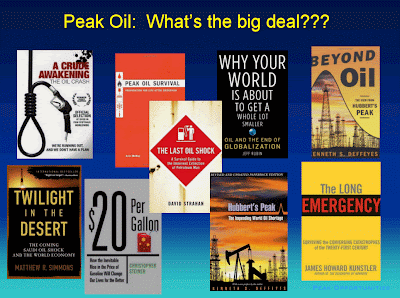



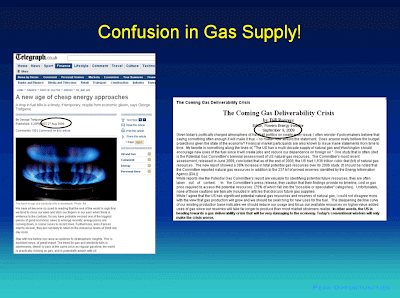

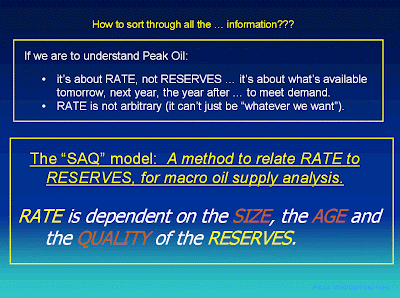
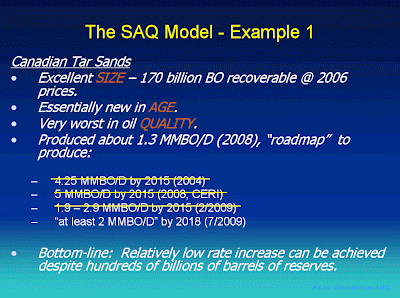

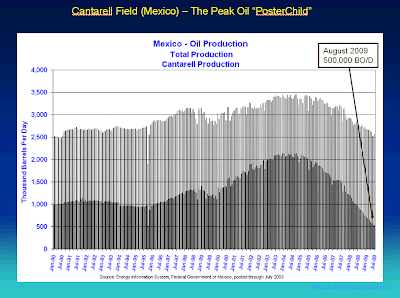


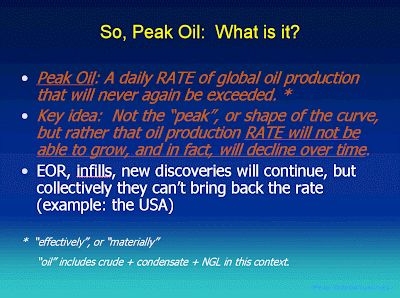
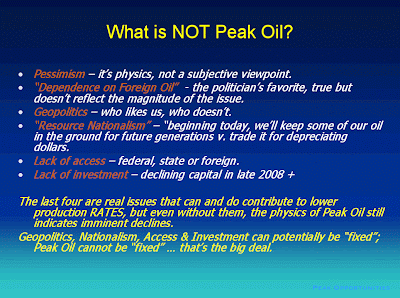
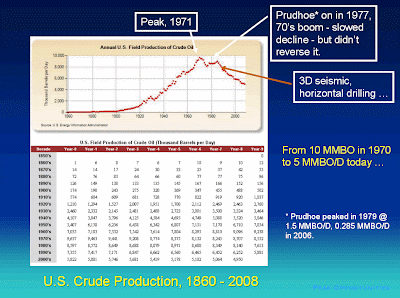
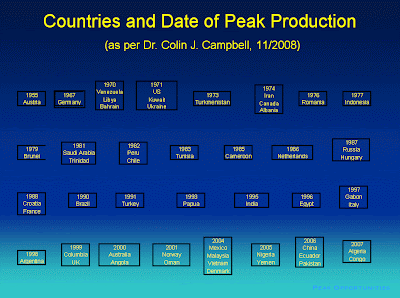


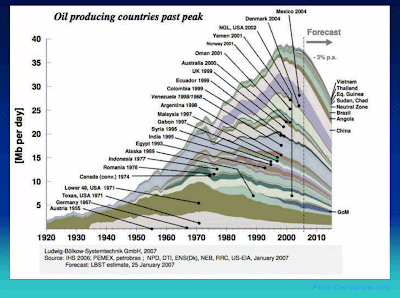



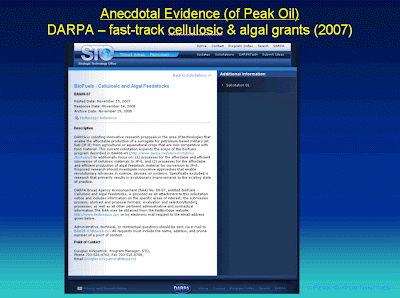



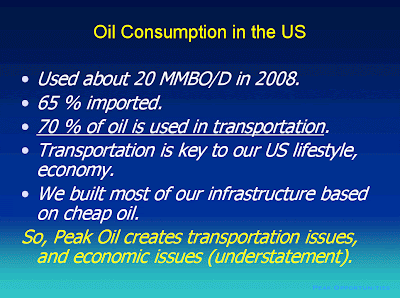

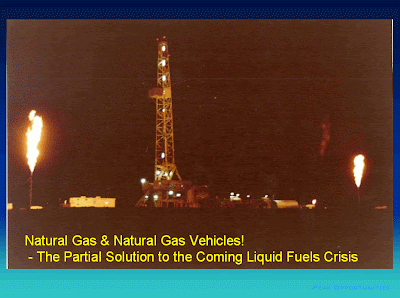


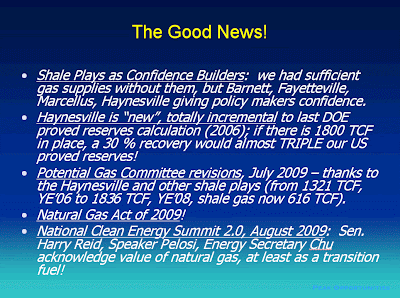
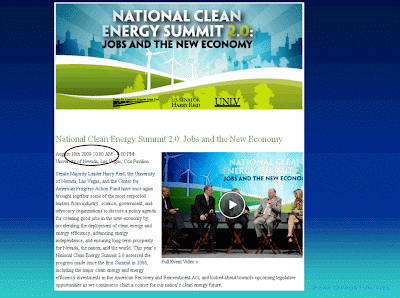

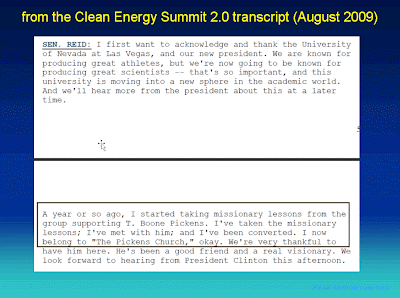





Since about 70 percent of the oil consumed in the USA is used for transportation, "Peak Oil" is really a transportation issue (initially, at least). It would be wonderful to be able to snap our fingers and have electric car or PHEV replacements (where applicable), but the electrical storage issues are still not resolved (lithium supplies for batteries, or a new technology), so production and replacement can't yet take place on a large scale.
The bottom-line is that we must have sufficient fossil fuels as we transition. And we will have to maintain a substantial level of oil and gas exploration and development activity - in fact an increased level of activity - as the law of diminishing returns takes over on the right hand side of Hubbert's Curve. If we continue to follow what seems like the vogue path of seeking to marginalize our fossil fuels industry, Hubbert's Curve will transform into Hubbert's Cliff, with even more catastrophic results at all levels of society and the economy. Such talk and action also drives a divisive stake into the heart of our nation. Fossil fuels or "clean", alternative energy? The reality is, as we transition over the next 20 years or so we will need substantial quantities of fossil fuels AND ramped-up conservation and alternative energy sources. In 40 years we will still need fossil fuels, but far less will be available. So, we must preserve and even enhance our fossil fuel infrastructure even as we ramp up alternative energy sources and implement substantial conservation.
Currently our nation and the world have a substantial endowment of recoverable natural gas. Natural gas emits half the carbon of coal, when burned. Further, natural gas can be used directly in vehicles, with fairly easy conversions using existing technology. Natural gas can also be a carbon-neutral, renewable fuel when it is produced from waste biomass (manure, landfills, etc.). So, given the impending oil shortage (currently masked by the economic downturn), and while we wait on electrical storage advances, it makes sense to convert a portion of our truck fleet, bus fleet and our passenger cars - to natural gas. If you want to see a lot of natural gas vehicles in action, just go to Italy, or Bolivia.
In an effort to continue to try to explain "Peak Oil", and also to make the case that natural gas is a suitable transition fuel for vehicles, the following presentation was developed for and delivered to the Gulf Coast Association of Geologic Societies, at their annual convention on September 27, 2009:
Statistics and Shale Plays ...
“There are three kinds of lies: lies, damn lies and statistics.”
Mark Twain
Recently it was noted that there are over ten times more bacterial and fungal cells on or in the average human - than there are human cells! (http://en.wikipedia.org/wiki/Human_flora)
As you can see, statistics don’t always tell the whole story. In fact, in this complicated world we can get badly misled if we limit our analyses to simple, reductionist statistics. Statistics can be quite helpful – but only if they are used in parallel with a full and correct understanding of all the available objective and subjective data.
Unfortunately, in this complicated world none of us has time to become “expert” on all things. As a result, we are forced to rely on simplifications or summaries done by others. Problems can ensure if those we are relying on have not gathered and correctly analyzed the requisite data, but instead have made statistical observations based on incomplete data or analyses. Further, in some cases it may not even be possible to come to a correct conclusion – even with all of the available data and the best analysis! The danger of statistics lies (pun intended) in the fact that statistics ALWAYS yield a numerical answer – an answer which may be premature, convoluted or just plain wrong.
So, statistics are not facts at all; rather, statistics are just numbers that may - or may not - represent a realistic analysis of a situation.
The Complexity of Shale Plays
Various rock parameters are required in order for a geographical portion of a given of a shale play to “work”. Just like the rock you see on the side of the road, these parameters vary across an area. We humans tend to subdivide things into convenient, already-existing “buckets”. In the case of land areas, counties are already defined, so we might say Blah County is “good”, and Blah Blah County is “not good”. The fact is, even in a play where 40 counties are “good”, there are always the “edges” - with “edges” representing the transitions between “good” and “not good”.
The noted Marcellus Shale expert, Dr. Terry Engelder of Penn State, has come up with the useful analogy of “toast” to explain the important shale gas geochemical parameter known as thermal maturity (sometimes referred to as Ro or Tm). In his slide show, Dr. Engelder shows partially cooked toast, charred toast, and toast that looks like it was cooked “just right”. The genius of this analogy is that we can all relate to properly cooked toast!
As it turns out, rock parameters don’t necessarily honor the county lines we have drawn. So, on the “edges” of a play part of a county may be perfectly cooked toast, and part of it may be burned toast! How do we find these edges? Sometimes data exists, but often it is spotty or undependable for whatever reason. Sometimes two analysts can look at the same data and come up with two different answers. Sometimes two analysts can come up with … five different answers! Also, rock parameters don’t follow straight lines on a map; they curve around – in here, out there.
So, often we have to find the edges the hard, expensive way - we have to drill multi-million dollar wells. And sometimes even when Company X thinks they know where the edge is, Company Y doesn’t have that same data. So, Company Y may wind up drilling a non-commercial well in an area that Company X had already condemned as “not good”. In this case, Company Y is viewed with disfavor. Given the full alphabet of companies out there, and given the infinitely curvy lines of rock parameters, there can be a lot of failed efforts along an “edge”. All these failed efforts can go into a statistical exercise that views a given portion of a given shale play in a simplistic way. Should the play in general, and Company X in particular, be condemned for the actions of Company Y and its alphabet brethren?
On the other hand, sometimes Company Y may have the same data as Company X, but Company Y thinks the data is suspect, or incomplete, or just has a different interpretation. So, in this case, Company Y takes the risk and drills a successful, multi-million dollar well. Company Y becomes a hero and in fact by extending the play in this direction, Companies Z, A, B - and even Company X - may benefit! Meanwhile, the royalty owners in this new area and the schoolchildren of that state (who sometimes get the benefits from the production taxes paid by Company Y and its royalty owners) become major beneficiaries of Company Y’s “guts”. Such is the nature of the oil and gas exploration business in unconventional shale plays!
Mark Twain
Recently it was noted that there are over ten times more bacterial and fungal cells on or in the average human - than there are human cells! (http://en.wikipedia.org/wiki/Human_flora)
Along comes a statistician, let’s call him Bob. Now Bob went to a good school, he’s a good public speaker, and he keeps his shoes shiny. All-in-all, Bob is a pretty credible guy. Bob works with a fellow named Billy Red. Billy’s a good guy too, but he’s in the kangaroo business and frankly, he’s a little miffed that humans are getting all the attention these days! Nevertheless, Bob is able to maintain his objectivity. Bob looks at the above discovery, does the math again himself, and states his conclusion, “Humans are not humans at all - they are bugs and mold!” “Why do you say that?”, someone asks. “Well, over half the cells on the subjects analyzed are bugs and mold, so therefore humans must be … bugs and mold!”, Bob replies.
Bob goes on to say, “Look, I wish it weren’t so. All I do is look at the FACTS. I’d be happy to go over this with anyone. I truly wish I was wrong.” What could be more reasonable?
Along comes Sam. Sam is a noted biologist with a long, distinguished career. In fact, Sam is currently director of the biological survey for his adopted state. Sam’s state mainly has birds, not humans. Over the years though, Sam has known a few humans and he’s found them, well … a little weird! Sam’s impressed with Bob, and believes he’s telling the truth. Sam recommends Bob and Bob’s work, and he goes on to exclaim, “Y’all better pay attention to what Bob has to say.” And so it goes that Bob’s credibility grows, and it’s not looking good for humans remaining to be classified as humans …
Who’s telling the truth here? What are the facts? Are humans, humans? Or are they bugs and mold?
Bob goes on to say, “Look, I wish it weren’t so. All I do is look at the FACTS. I’d be happy to go over this with anyone. I truly wish I was wrong.” What could be more reasonable?
Along comes Sam. Sam is a noted biologist with a long, distinguished career. In fact, Sam is currently director of the biological survey for his adopted state. Sam’s state mainly has birds, not humans. Over the years though, Sam has known a few humans and he’s found them, well … a little weird! Sam’s impressed with Bob, and believes he’s telling the truth. Sam recommends Bob and Bob’s work, and he goes on to exclaim, “Y’all better pay attention to what Bob has to say.” And so it goes that Bob’s credibility grows, and it’s not looking good for humans remaining to be classified as humans …
Who’s telling the truth here? What are the facts? Are humans, humans? Or are they bugs and mold?
As you can see, statistics don’t always tell the whole story. In fact, in this complicated world we can get badly misled if we limit our analyses to simple, reductionist statistics. Statistics can be quite helpful – but only if they are used in parallel with a full and correct understanding of all the available objective and subjective data.
Unfortunately, in this complicated world none of us has time to become “expert” on all things. As a result, we are forced to rely on simplifications or summaries done by others. Problems can ensure if those we are relying on have not gathered and correctly analyzed the requisite data, but instead have made statistical observations based on incomplete data or analyses. Further, in some cases it may not even be possible to come to a correct conclusion – even with all of the available data and the best analysis! The danger of statistics lies (pun intended) in the fact that statistics ALWAYS yield a numerical answer – an answer which may be premature, convoluted or just plain wrong.
So, statistics are not facts at all; rather, statistics are just numbers that may - or may not - represent a realistic analysis of a situation.
The Complexity of Shale Plays
Various rock parameters are required in order for a geographical portion of a given of a shale play to “work”. Just like the rock you see on the side of the road, these parameters vary across an area. We humans tend to subdivide things into convenient, already-existing “buckets”. In the case of land areas, counties are already defined, so we might say Blah County is “good”, and Blah Blah County is “not good”. The fact is, even in a play where 40 counties are “good”, there are always the “edges” - with “edges” representing the transitions between “good” and “not good”.
The noted Marcellus Shale expert, Dr. Terry Engelder of Penn State, has come up with the useful analogy of “toast” to explain the important shale gas geochemical parameter known as thermal maturity (sometimes referred to as Ro or Tm). In his slide show, Dr. Engelder shows partially cooked toast, charred toast, and toast that looks like it was cooked “just right”. The genius of this analogy is that we can all relate to properly cooked toast!
As it turns out, rock parameters don’t necessarily honor the county lines we have drawn. So, on the “edges” of a play part of a county may be perfectly cooked toast, and part of it may be burned toast! How do we find these edges? Sometimes data exists, but often it is spotty or undependable for whatever reason. Sometimes two analysts can look at the same data and come up with two different answers. Sometimes two analysts can come up with … five different answers! Also, rock parameters don’t follow straight lines on a map; they curve around – in here, out there.
So, often we have to find the edges the hard, expensive way - we have to drill multi-million dollar wells. And sometimes even when Company X thinks they know where the edge is, Company Y doesn’t have that same data. So, Company Y may wind up drilling a non-commercial well in an area that Company X had already condemned as “not good”. In this case, Company Y is viewed with disfavor. Given the full alphabet of companies out there, and given the infinitely curvy lines of rock parameters, there can be a lot of failed efforts along an “edge”. All these failed efforts can go into a statistical exercise that views a given portion of a given shale play in a simplistic way. Should the play in general, and Company X in particular, be condemned for the actions of Company Y and its alphabet brethren?
On the other hand, sometimes Company Y may have the same data as Company X, but Company Y thinks the data is suspect, or incomplete, or just has a different interpretation. So, in this case, Company Y takes the risk and drills a successful, multi-million dollar well. Company Y becomes a hero and in fact by extending the play in this direction, Companies Z, A, B - and even Company X - may benefit! Meanwhile, the royalty owners in this new area and the schoolchildren of that state (who sometimes get the benefits from the production taxes paid by Company Y and its royalty owners) become major beneficiaries of Company Y’s “guts”. Such is the nature of the oil and gas exploration business in unconventional shale plays!
Wednesday, January 20, 2010
Changing Our Hearts
Changing - the change or changes we'd all like to see ... begin with us.
Our - inclusive; we're all in this together - "our" hearts means our own, individual hearts, our Austin, our Texas, our USA, our World hearts ...
Hearts - most folks are familiar with the phrase "what's in your heart"; heart is essentially synonymous with love, which is fundamental to the Greatest Commandment.
Note: A new year is a time of renewal, so it should be with a "blog". The above is actually my entry to a "vision statement contest" at church. I accidentally published it here on the Peak Opportunities blog, when I thought I was submitting it to the church blog. I was about to remove it when I thought, no, it belongs here as well.
Most of us in the "Peak Oil Community" believe that "Peak Oil" is essentially old news, by now. This despite the fact that probably 75 % of folks have never heard of it, by my crude estimates (little pun problem I seem to have). Of that 25 % who have heard of Peak Oil, maybe only half of those understand it and believe it. Nevertheless, from here on we'll try to focus more on the Peak Opportunities - the action items - and less on "proving up Peak Oil".
Sure, we'll have the occasional news on the Cantarell declines, and a few statistics here and there. However, we'll try to focus more on what we can do, what we can change. Not that we haven't had some big picture ideas before (see our The Coming Liquid Fuels Crisis: The Natural Gas Partial Solution.) But from Peak Oil we'll drill down (can't seem to help it) as we can - and we'll "drill up" (philosophize) a little, too.
Our - inclusive; we're all in this together - "our" hearts means our own, individual hearts, our Austin, our Texas, our USA, our World hearts ...
Hearts - most folks are familiar with the phrase "what's in your heart"; heart is essentially synonymous with love, which is fundamental to the Greatest Commandment.
Note: A new year is a time of renewal, so it should be with a "blog". The above is actually my entry to a "vision statement contest" at church. I accidentally published it here on the Peak Opportunities blog, when I thought I was submitting it to the church blog. I was about to remove it when I thought, no, it belongs here as well.
Most of us in the "Peak Oil Community" believe that "Peak Oil" is essentially old news, by now. This despite the fact that probably 75 % of folks have never heard of it, by my crude estimates (little pun problem I seem to have). Of that 25 % who have heard of Peak Oil, maybe only half of those understand it and believe it. Nevertheless, from here on we'll try to focus more on the Peak Opportunities - the action items - and less on "proving up Peak Oil".
Sure, we'll have the occasional news on the Cantarell declines, and a few statistics here and there. However, we'll try to focus more on what we can do, what we can change. Not that we haven't had some big picture ideas before (see our The Coming Liquid Fuels Crisis: The Natural Gas Partial Solution.) But from Peak Oil we'll drill down (can't seem to help it) as we can - and we'll "drill up" (philosophize) a little, too.
Subscribe to:
Posts (Atom)